
About the History of the Great War
on the Austro-Italian Front
as recorded in
Author Gaetano V. Cavallaro's
3 Volumes:
The Beginning of Futility,
Futility Ending in Disaster
and
Disaster Ending In Final Victory
HOW TO PURCHASE BOOKS
dominated by Anglocentric and English language,
leaving much in question regarding content and
source. Having visited archives in Vienna, Rome,
Paris and London, in addition to extensive communications with other archival sources,
the author has strived to present the first
complete and accurate picture of events on the
Austro-Italian Front during the Great War.
Since the author believes that war is a
continuation of diplomacy, The Beginning of
Futility includes the diplomatic background
of events after the assassination of
Archduke Francis Ferdinand.
As a treaty ally of the Central Powers, Italy
declared its neutrality, noting that Vienna
was the attacking party, since the Triple
Alliance was a defensive treaty. Enticed by
London and attracted by the compensation of
many of the Habsburg’s Italian-speaking
territories, Italy agreed to join the allies.
Fighting on this front were a young
Lt. Erwin Rommel of future fame and
tragic end, Ernest Hemingway, the Nobel
prize-winning novelist serving in the Italian
army as a volunteer ambulance driver and
later in the Arditi, as well as future Italian
President Giovanni Gronchi.
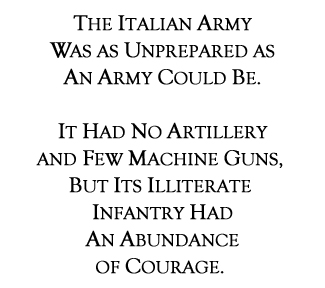
The Italian Army was as unprepared as an
army could be. It had no artillery and few
machine guns, but its illiterate infantry had an
abundance of courage. In multiple offensives
employing the by-now defunct attacco frontale,
the fanti* pushed back the Austro-Hungarian
forces. The price of this success was half a
million dead, one million wounded and one
hundred thousand men starved to death in
Prisoner of War camps, ending up with poor
morale by the fall of 1917. Finally, Vienna
asked for German help to push the Italian
forces back.
Futility Ending in Disaster with Final
Victory illustrates the new tactics used by the
Austro-German forces who rolled the dice in
the first example of blitzkrieg that the world
has ever known. The mistreated fanti who had
suffered poor food, decimation and lack of care
for their families, surrendered in droves. After
two weeks, the enemy penetrated one hundred
miles deep into Italian territory, arriving at the
Piave River and the mountains to the north,
all of which provided a natural defense.
Below: German troops preparing to attack
during the Battle of Caporetto,
Oct. 24, 1917
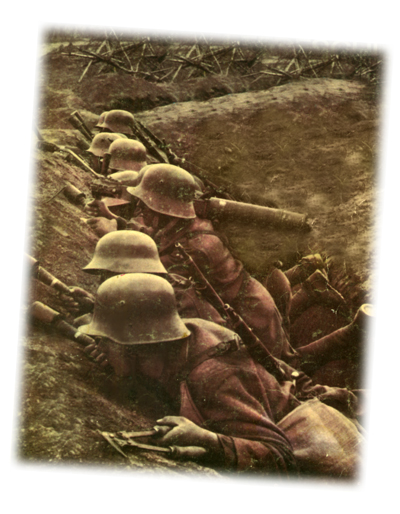
the Battle of Caporetto,
Oct. 24, 1917
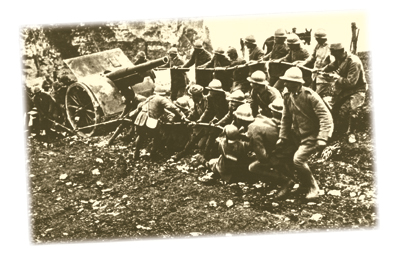
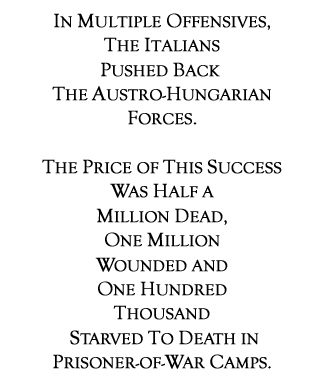
Villages
Mountain
Peaks
Cities or
Major
Centers

Above: Map of the Battle of Caporetto, October 23, 1917
Over six hundred thousand men were lost as
were thousands of guns which had arrived
from the allies. Alarmed, the British and
French immediately sent troops to the sector.
Should Italy have collapsed, five million
combat-hardened veterans would have been
sent to the Western Front to overrun the
Anglo-French before the Americans could arrive.
Suddenly for reasons yet unknown, the fanti
stood off the enemy attacks in the mountains
as well as on the river. Most had never seen
snow or ice, but fought like wounded tigers
halting the enemy. Simultaneous with this
huge victory, Vienna was negotiating a
unilateral peace via emissaries in Sweden
and Switzerland to Lloyd George and President
Woodrow Wilson, who had decided that the
allies could not win the war. These talks
ended in failure. In 1918, Wilson started to
make speeches which indirectly encouraged
the ethnics in the Habsburg Empire to rebel.
The following June, Vienna attempted another
offensive through the mountains and on the
Piave, all of which failed, causing the Habsburgs
to await inevitable defeat. On October 16, 1918,
Emperor Charles issued the Manifesto which
stated that all ethnics in the empire would be
allowed to form their own nations, provided
they were under the federation of the
Habsburg Crown.
Below: Classic fog in mountains along Isonzo River,
photographed October 24, 2002, contributed to the
demise of over 600,000 soldiers

for discarding his rifle

Courtesy Museo del Risorgimento, Milano

Above: Map of the Italian-Austrian Battle Front, 1915
Villages
Cities or
Major
Centers
On October 24th, the Italian Army started the Battle of
Vittorio Veneto. Vienna decided to withdraw its forces
from occupied Italy. As the men left occupied Italy
pursued by Italian troops, they walked thousands
of miles to their emerging Fatherlands without food,
water or shelter. Ethnics in the empire were declaring
their independence. In Vienna, Emperor Charles was
incapable of handling the crisis. His officers realized
the severity of the situation and surrendered his army.
Charles gave command of the army to the Senior
Feldmarschall.
The new nations never achieved the economic
well-being they had experienced under the
Habsburg Crown.
* fanti is an Italian term meaning infantry
Below: British engineers preparing to install
barbed wire, June 1918
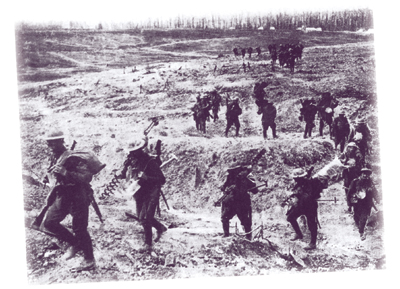
For information about purchasing books, individually or as a complete boxed set,
as well as any other questions, please contact:
info@WorldWarOneHistory.com
About | Author | Lecturer | Review | Purchase Books | Site Map | Contact | Home
Privacy | © 2010 WorldWarOneHistory.com